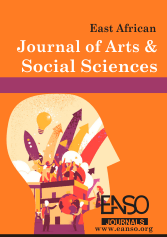Exposure of Women in Politics to Media Coverage and Their Ability to Raise Self-Esteem of Children in Nakuru County
Abstract
As the number of women in politics continues to increase worldwide, balancing their political and parenting roles may pose a challenge. The study was carried out to investigate the effects of exposure of women to media coverage on their ability to raise the self-esteem of their children in Nakuru County. The study adopted an ex post facto research design. The study had an accessible population of 129 respondents that comprised 105 women members of county assembly aspirants, 12 women parliamentary aspirants, 10 women representative aspirants and two women senatorial aspirants in Nakuru County during the 2017 general elections. The census sampling technique was used to select all the 129 respondents. Data was collected using a questionnaire. The content and face validity of the questionnaire were ascertained of the study objectives and advice by experts from the Department of Applied Community Development Studies of Egerton University. To estimate the reliability of the instrument, a pilot study was conducted on fourteen women political aspirants who participated in the 2017 general elections from neighbouring Nyandarua County. The questionnaire was considered reliable when it attained an estimated Cronbach Alpha coefficient of 0.78. The questionnaire was self-administered with the guidance from the researcher. Quantitative data was summarized in frequency distribution tables and the responses were analysed using simple regression analysis methods with the help of SPSS computer package 25.0 version. Qualitative data was summarized in emerging themes based on the objectives of the study. The study revealed that exposure of women to media coverage affected their ability to raise the self-esteem of their children in Nakuru County (β- 0.790) at 0.05 level of significance. The study findings may offer insights to women politicians, education researchers and other stakeholders on the importance of parenthood and the challenges faced by women politicians
Downloads
References
Ahmedweli, K. M. (2019). Factors Affecting Women Political Leadership in Benadir Region, Somalia. International Journal of Academics & Research. Article 06www.ijarke.com
Awotash A (2010) Women Participation in Parliament: comparative analysis: Emphasis Given to South Africa and Ethiopia. International Journal of Education and Policy Studies, 5(2), 105-190.
Bochaberi, N. M. (2009). Women’s participation in political processes in Kenya: the case of Nyamira County 1963-2013. Nairobi: Kenyatta University.
Chowdhury, F. D. (2009). Problems of Women’s Participation in Bangladesh Politics. The Round Table, 98(404), 555-567.
Haregewoin, C & Emebet, M (2003) Towards Gender Equality in Ethiopia. Addis Ababa: IDA.
Heldman, C, Susan J. Carroll, N & Olson, S (2006). Traits versus Issues: How Female Candidates Shape Coverage of Senate and Gubernatorial Races. Political Research Quarterly, 66, 715-726. https://www.jstor.org/stable/23563177.
Inglehart, R and Norris, P (2003). Rising Tide: Gender Equality and Cultural Change around the World. Cambridge: Cambridge University Press.
Inglehart, R. (2000). Rising Tide: Gender Equality and Cultural Change around the World. Cambridge: Cambridge University Press.
Kassa, S. (2015). Challenges and Opportunities of Women Political Participation in Ethiopia. Journal of Global Economics.
Khan, A., (2010). Enhancing the women empowerment in the traditional society in Pakistan. Journal of Development Studies. Retrieved from https://www.grin.com/document/341908.
Krook, L (2019. The Cost of Doing Politics. Analyzing Violence and Harassment against Female Politicians. Perspectives on Politics, 18, 3.
Meeks, Lindsey. 2012. ‘Is she „man enough’? Women Candidates, Executive political offices, and news coverage. Journal of Communication (62): 175-93.
Miki and Kim (2007). Gender, candidate portrayals and election campaigns: A comparative perspective. Politics and Gender 4(03):371 – 392. DOI: 10.1017/S1743923X08000330.
Mittulah, V W &Owiti (2011) Gender inclusion in transition politics: A review and critique of women's engagement.
Norris, P. (2002). Democratic Phoenix: Reinventing political activism. Cambridge University Press.
Phillips, D. (2007). Ethnic and Racial Segregation: A Critical Perspective. https://doi.org/10.1111/j.1749-8198.2007.00051.x.
RoK (2010). Constitution of Kenya 2010. Nairobi: Government Printer.
Ross K. (2017). Gender, Politics, News: A Game of Three Sides, First Edition.
Schlehofer, M, Bettina, J. Casad, M, Bligh, C & Angela R. (2011). Navigating Public Prejudices: The Impact of Media and Attitudes on High-Profile Female Political Leaders. Journal of Sex Roles 65: 69-82.
Copyright (c) 2024 James Njoroge Waweru, Dolphine Odero-Wanga, PhD, Nancy Openda, PhD

This work is licensed under a Creative Commons Attribution 4.0 International License.




























